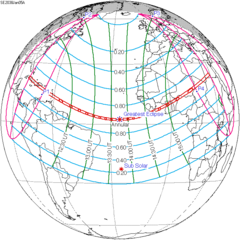
A total lunar eclipse occurred from 5:27 to 11:06 UTC on 21 December 2010, coinciding with the date of the Winter solstice in the Northern Hemisphere and Summer solstice in the Southern Hemisphere. It was visible in its entirety as a total lunar eclipse in North and South America, Iceland, Ireland, Britain and northern Scandinavia.

A total lunar eclipse took place on Friday, February 9, 1990, the first of two lunar eclipses in 1990.
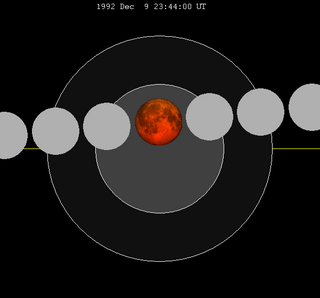
A total lunar eclipse took place on Wednesday, December 9, 1992, the second of two lunar eclipses in 1992, the first was a partial lunar eclipse on Monday, June 15.

A partial lunar eclipse was visible on 31 December 2009. It was the last and largest of four minor lunar eclipses in 2009. This lunar eclipse was also notable, because it occurred during a blue moon and was near perigee. The next eclipse on New Year's Eve and blue moon will occur on 31 December 2028.

A penumbral lunar eclipse took place on Sunday 26 May 2002, the first of three lunar eclipses in 2002.
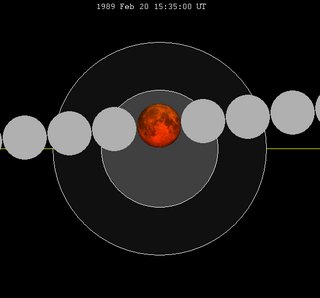
A total lunar eclipse took place on Monday, February 20, 1989, the first of two total lunar eclipses in 1989.

A total lunar eclipse will take place on July 7, 2047. It will last 1 hour 40 minutes and 49 seconds and will plunge the full Moon into deep darkness, as it passes right through the centre of the Earth's umbral shadow. While the visual effect of a total eclipse is variable, the Moon may be stained a deep orange or red colour at maximum eclipse. This will be a great spectacle for everyone who sees it. The partial eclipse will last for 3 hours and 39 minutes in total.
A total lunar eclipse took place on Friday, November 29, 1974, the second of two lunar eclipses in 1974. The Moon was plunged into darkness for 1 hour, 15 minutes and 45 seconds, in a deep total eclipse which saw the Moon 28.961% of its diameter inside the Earth's umbral shadow. The visual effect of this depends on the state of the Earth's atmosphere, but the Moon may have been stained a deep red colour. The partial eclipse lasted for 3 hours, 28 minutes and 58.7 seconds in total. The penumbral eclipse lasted for 5 hours, 33 minutes and 11.6 seconds. The partial eclipse lasted for 3 hours, 28 minutes and 58.7 seconds. The total eclipse lasted for 1 hour, 15 minutes and 45 seconds. Occurring only 3.6 days before perigee, the Moon's apparent diameter was 1.4% larger than average.

A partial lunar eclipse occurred on 19 November 2021. The eclipse occurred towards a micromoon. This was the longest partial lunar eclipse since 18 February 1440, and the longest until 8 February, 2669; however, many eclipses, including the November 2022 lunar eclipse, have a longer period of umbral contact at next to 3 hours 40 minutes. It was often referred to as a "Beaver Blood Moon" although not technically fulfilling the criteria for a true blood moon (totality).

A partial lunar eclipse will take place on Wednesday, January 12, 2028.

A partial lunar eclipse will take place on Thursday, July 6, 2028.
A total lunar eclipse took place on Sunday, January 30, 1972, the first of two lunar eclipses in 1972. The moon entered the Earth's penumbral shadow at 30 January 1972 08:03:12.5 UTC and exited at 30 January 1972 13:43:37.9 UTC. The moon entered the Earth's umbral shadow at 30 January 1972 09:11:38.4 UTC and exited at 30 January 1972 12:35:03.1 UTC. Totality lasted 34 minutes, 47.7 seconds, between 10:35:57.4 UTC and 11:10:45.1 UTC. The moon was 6.6 days before apogee, making it 1.6% smaller than average, only 0.2% larger than the July 1972's lunar eclipse.
A partial lunar eclipse occurred on Tuesday, July 25, 1972 and Wednesday, July 26, 1972, the second of two lunar eclipses in 1972 with an umbral eclipse magnitude of 0.54271. A partial lunar eclipse occurs when the Earth moves between the Sun and Moon but the three celestial bodies do not form a straight line in space. When that happens, a small part of the Moon's surface is covered by the darkest, central part of the Earth's shadow, called the umbra. The rest of the Moon is covered by the outer part of the Earth's shadow called the penumbra. The moon's apparent diameter was 3.2 arcseconds smaller than the January 30, 1972 lunar eclipse.

A total solar eclipse occurred at the ascending node of the Moon's orbit on Tuesday, July 2, 2019, with an eclipse magnitude of 1.0459. Totality was visible from the southern Pacific Ocean east of New Zealand to the Coquimbo Region in Chile and Central Argentina at sunset, with the maximum of 4 minutes 33 seconds visible from the Pacific Ocean. The Moon was only 2.4 days before perigee, making it fairly large.
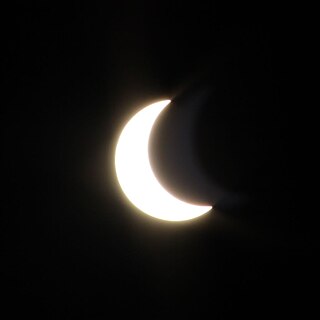
An annular solar eclipse took place on February 26, 2017. A solar eclipse occurs when the Moon passes between Earth and the Sun, thereby totally or partly obscuring the image of the Sun for a viewer on Earth. An annular solar eclipse occurs when the Moon's apparent diameter is smaller than the Sun's, blocking most of the Sun's light and causing the Sun to look like an annulus (ring). An annular eclipse appears as a partial eclipse over a region of the Earth thousands of kilometres wide. Occurring only 4.7 days before perigee, the Moon's apparent diameter was larger. The moon's apparent diameter was just over 0.7% smaller than the Sun's.

A total solar eclipse will occur on December 5, 2048. A solar eclipse occurs when the Moon passes between Earth and the Sun, thereby totally or partly obscuring the image of the Sun for a viewer on Earth. A total solar eclipse occurs when the Moon's apparent diameter is larger than the Sun's, blocking all direct sunlight, turning day into darkness. Totality occurs in a narrow path across Earth's surface, with the partial solar eclipse visible over a surrounding region thousands of kilometres wide.
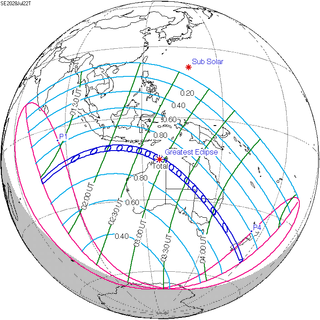
A total solar eclipse will occur on Saturday, July 22, 2028. The central line of the path of the eclipse will cross the Australian continent from the Kimberley region in the north-west and continue in a south-easterly direction through Western Australia, the Northern Territory, south-west Queensland and New South Wales, close to the towns of Wyndham, Kununurra, Tennant Creek, Birdsville, Bourke and Dubbo, and continuing on through the centre of Sydney, where the eclipse will have a duration of over three minutes. It will also cross Queenstown and Dunedin, New Zealand. Totality will also be viewable from two of Australia's external territories: Christmas Island and the Cocos (Keeling) Islands.

An annular solar eclipse will occur on Monday, May 31, 2049. A solar eclipse occurs when the Moon passes between Earth and the Sun, thereby totally or partly obscuring the image of the Sun for a viewer on Earth. An annular solar eclipse occurs when the Moon's apparent diameter is smaller than the Sun's, blocking most of the Sun's light and causing the Sun to look like an annulus (ring). An annular eclipse appears as a partial eclipse over a region of the Earth thousands of kilometres wide.
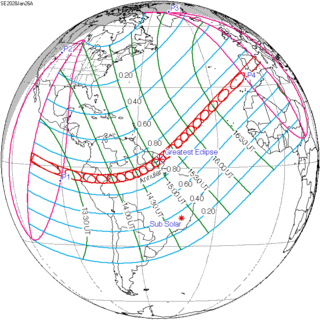
An annular solar eclipse will occur on Wednesday, January 26, 2028. A solar eclipse occurs when the Moon passes between Earth and the Sun, thereby totally or partly obscuring the image of the Sun for a viewer on Earth. An annular solar eclipse occurs when the Moon's apparent diameter is smaller than the Sun's, blocking most of the Sun's light and causing the Sun to look like an annulus (ring). An annular eclipse appears as a partial eclipse over a region of the Earth thousands of kilometres wide.
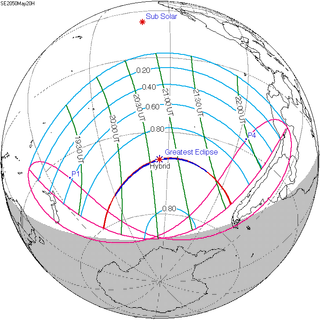
A total solar eclipse will occur on May 20, 2050. A solar eclipse occurs when the Moon passes between Earth and the Sun, thereby totally or partly obscuring the image of the Sun for a viewer on Earth. A total solar eclipse occurs when the Moon's apparent diameter is larger than the Sun's, blocking all direct sunlight, turning day into darkness. Totality occurs in a narrow path across Earth's surface, with the partial solar eclipse visible over a surrounding region thousands of kilometres wide. This eclipse is a hybrid eclipse, starting and ending as an annular solar eclipse.





















